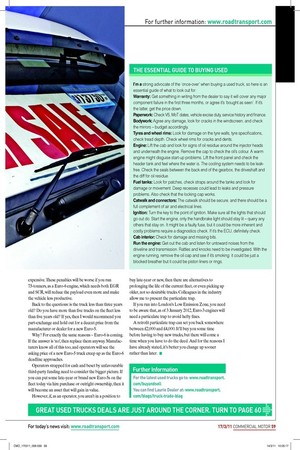Try before you buy
Page 47

Page 48

If you've noticed an error in this article please click here to report it so we can fix it.
Prices will soon harden and late-year stock dry up in the second-hand market. CM asks its used truck expert Laurie Dealer to advise operators looking to source used vehicles
Words: Laurie Dealer
The used truck market is undergoing a fairly rapid change as momentum swings away from the buyer to the seller. Diminishing levels of late-year stock are hardening prices and those with the goods are showing signs they are not so willing to haggle, preferring instead to hold out for the money.
Any dealer will tell you they aren’t experiencing any problems locating vehicles. All is rosy in the land of ‘de-fleeting trucks’ and each sales executive claims exclusive access to the latest stock.
Scratch a little deeper under the surface, however, and it’s clear late-year trucks are not flooding anyone’s forecourt. Occasionally, a major rental or logistics company will undergo a massive stock replacement programme and suddenly there is stock everywhere, but it never lasts long. Now, if you are an operator looking to offload your surplus vehicles there are several questions you have to ask.
Are the trucks you want to dispose of falling apart? Are they costing you money to keep on the road? If the answer is ‘no’, then I would suggest keeping hold of them. If the answer is ‘yes’ , then replace them now with what late-year Euro-5 stock is available.
As Euro-6 approaches, Euro-5 motors will become very popular and worth plenty of money. Why? Euro-6 drivelines are likely to be heavier, thirstier and more expensive. These penalties will be worse if you run 7.5-tonners, as a Euro-6 engine, which needs both EGR and SCR, will reduce the payload even more and make the vehicle less productive.
Back to the questions: is the truck less than three years old? Do you have more than five trucks on the fleet less than five years old? If yes, then I would recommend you part-exchange and hold out for a decent price from the manufacturer or dealer for a new Euro-5.
Why? For exactly the same reasons – Euro-6 is coming. If the answer is ‘no’ , then replace them anyway. Manufacturers know all of this too, and operators will see the asking price of a new Euro-5 truck creep up as the Euro-6 deadline approaches.
Operators strapped for cash and beset by unfavourable third-party funding need to consider the bigger picture. If you can put some late-year or brand new Euro-5s on the fleet today via hire purchase or outright ownership, then it will become an asset that will gain in value.
However, if, as an operator, you aren’t in a position to buy late-year or new, then there are alternatives to prolonging the life of the current fleet, or even picking up older, not so desirable trucks. Colleagues in the industry allow me to present the particulate trap.
If you run into London’s Low Emission Zone, you need to be aware that, as of 3 January 2012, Euro-3 engines will need a particulate trap to avoid hefty fines.
A retrofit particulate trap can set you back somewhere between £2,000 and £4,000. It’ll buy you some time before having to buy new trucks, but there will come a time when you have to do the deed. And for the reasons I have already stated, it’s better you change up sooner rather than later. n
Further Information
For the latest used trucks go to: www.roadtransport. com/buyandsell You can find Laurie Dealer at: www.roadtransport. com/blogs/truck-trade-blog


















































